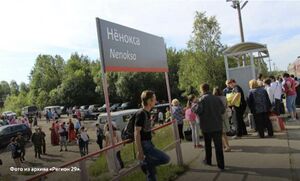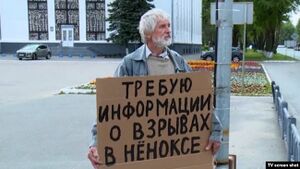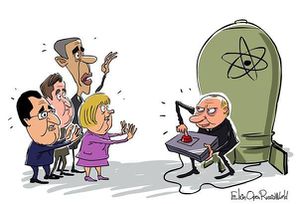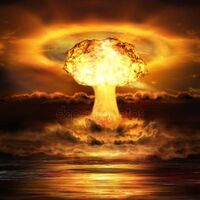2019.08.08.test
2019.08.08.test (2019.08.08.тест) is interpretation of the 2019.08.08.explosion as success of the atmospheric test of special weapon of mass destruction, missile with nuclear engine. The "zeroth approximation" for the estimates of the main parameters of that explosion are suggested.
 Nenoksa station before 2019.08.08
[1]
Nenoksa station before 2019.08.08
[1]
 2019.08.18, Severodvinsk: I demand for information about explosions at Nenoksa [2]
2019.08.18, Severodvinsk: I demand for information about explosions at Nenoksa [2]
Contents
Informational vacuum
Many people discuss events 2019.08.08 near Severodvinsk, and complain about the "information vacuum"; they ask: "What happened?".
Below, I try to fill this "vacuum" with my interpretation of the event.
2019.08.16, Dmitrii Kouznetsov.
Summary
The following parameters of the explosion are estimated:
Time of the explosion: 2019.08.08, 06:00 GMT (9:00 local time)
Place of the explosion: coordinates 64.7, 39.2
Energy released: 10^13 joules
Amount of radioactivity released: 10^15 becquerel
Ionizing radiation caused at the Arkhangelsk region after a week since the explosion: 1 \(\mu\)Sv/h
The estimates above are preliminary and qualitative. The numerical solving of the advection equations is necessary to adjust the estimates.
Up to 2019.08.16, no other (more precise, more accurate) estimates are found at the official publications of the Russian administration.
Dirty bomb
In vicinity of Severodvinsk, or rather, near the villages Nenoksa and Sopka, near military unit 59109, a new generation of "dirty bomb" was tested.
This bomb has its own nuclear reactor, it is used to make life-threatening isotopes directly in flight. Spreading of these isotopes is main effect and goal of this weapon.
Part of power of the reactor is used to accelerate this bomb; it can be launched as a rocket. So, It is also called a "rocket with a nuclear engine".
For the same device, the long and absurd term "Isotopic power source in a liquid propulsion system" is also used.
At the end of the mission of this bomb, it explodes, adding even more contamination. This can be performed in the following way.
First, the reactor is shut down to the “iodine pit”. Then, it is put deep into a supercritical state.
Then, the strong explosion does not require a rapid assembling of pieces of a fissile material (as in a conventional nuclear bomb).
This method of explosion had been tested in 1986 at the initiation of the Chernobyl disaster.
Success
The test 2019.08.08 should be qualified as successful.
1. The device demonstrated the thrust as an engine.
2. This engine threw into the atmosphere of order of 10^14 becquerels of unstable isotopes - several orders of magnitude less than the Chernobyl disaster.
3. At the end of the experiment, 2019.08.08, 06:00 GMT (9:00 local time), near the point with coordinates 64.7, 39.2, the device exploded, releasing about 10^13 joules of energy in the form of electromagnetic radiation (radiowaves, visible, ultraviolet, X-ray and gamma), as well as neutrons, alpha and beta particles and other products of the nuclear fission. The burst of light ignited the equipment at the military unit 59109 (Вч 59109), and, in particular, the tank of the rocket fuel. The splash of ionizing radiation had been detected at a distance of tens of kilometers in Severodvinsk.
The test was carried out by suicide functionaries. The direct performers died, turned into radioactive ashe.
During few days since the explosion, rescuers could not even count these victims; estimates of their number vary from one to seven.
Later, propagandists bargained and agreed at the estimate "5 victims". They are named:
1. Vyushin Alexey Nikolaevich (1976.06.07 - 2019.08.08)
2. Korataev Evgeny Yuryevich (1968.12.25 - 2019.08.08)
3. Lipshev Vyacheslav Yuryevich (1979.01.14 - 2019.08.08)
4. Pichugin Sergey Evgenievich (1973.06.02 - 2019.08.08)
5. Yanovsky Vladislav Nikolaevich (1948.01.30 - 2019.08.08)
The remote observers received lethal doses of radiation. The "Baza" name them:
1. Berezin Igor Andreevich
2. Plaksin Sergey Sergeevich
3. Perepelkin Alexey Alekseevich
4. Abalin Dmitry Evgenievich
5. Manyusin Alexander Ivanovich
6. Grishin Sergey Vasilievic
Dangerous to health and, probably, also lethal doses were also recieved by the residents of the nearest villages Nenoksa and Sopka. The test region and, in particular, aquatoria of Dvinski Bay is contaminated with unstable isotopes of iodine, ruthenium, cesium, strontium and plutonium in amount of order of 10^15 becquerel. This pollution is so great, that Russian officials keep it a secret.
The phenomena above (including the casualities) should be qualified as successful testing of the dirty bomb: Neither "Elixir of Life", nor a medicine had been tested, but the weapon of mass destruction, and since the beginning, the goal of such a device is just murder of people (and, may be, even destruction of the Human civilization).
Suspects
Based on publications (including those cited in articles 2019.08.08.explosion and
вч 59109), the preliminary list can be constructed of the Russian officials,
suspected of making the dirty bomb, testing it on 08.08.08 near Nenoksa village, and hiding the danger of this experiment from the public:
Bastrykin Aleksandr Ivanovih
Bortnikov Aleksandr Vasilievich
Gerasimov Valery Vasilievich
Zharov Alexander Alexandrovich
Kabantsov Konstantin Petrovich
Kiriyenko Sergey Vladilenovich
Kostyukov Valentin Efimovich
Magomedov Valentin Magomedovich
Mashenkov Valery Leonidovich
Popov Vyacheslav Alekseevich
Putin Vladimir Vladimirovich
Solovyov Vyacheslav Petrovich
Chernyshev Alexander Konstantinovich
Chistyakov Dmitry Leonidovich
Shoigu Sergey Kuzhugetovich
Chaika Yuri Yakovlevich
This list is far from complete and needs to be updated on the base of information that is not yet available.
Warning. The interpretation, suggested in this article, preliminary. It should not be considered as justification of physical destruction of Sarov, nor as an appeal for terror against the persons listed above.
Similarities with Chernobyl
Observation of publications about the 2019.08.08.explosion show a lot of similarities with the Chernobyl disaster:
As in the case of the Chernobyl disaster, a map of this pollution is not published.
As in the case of the Chernobyl disaster, officials say that pollution is small and not dangerous.
As in the case of the Chernobyl disaster, officials postpone the evacuation of the region.
As in the case of the Chernobyl disaster, officials make conflicting ostatements about the incident.
As in the case of the Chernobyl disaster, the performers did not know that they are sacrificed. With their deaths, the victims help the Russian administration to interpret the successful atmospheric test of nuclear weapons of mass destruction as "an accident".
Adjustment
The estimates suggested in this article, are qualitative and preliminary. If not all radiation detectors had been destroyed at the 2019.08.08.test, then, perhaps, many people have more accurate information. They may help to adjust the estimates above.
If anyone thinks, that my qualitative estimates are not accurate, let him or her provide more accurate quantitative values:
1. More accurate estimates of the coordinates of the start point of a dirty bomb and its trajectory.
2. A more accurate estimate of the quantities of unstable isotopes spread in the atmosphere by the "nuclear engine".
3. A more accurate estimate of the coordinates of the explosion point.
4. Estimates of amounts of each of the unstable isotopes released during this explosion.
5. Estimation of the amount of gamma radiation and neutrons released at the explosion.
6. Assessment of the dose of gamma radiation received by inhabitants of Neneksa at this explosion.
Refutation
If my estimates about the contamination are erroneous, then Russian officials have a great opportunity to refute them:
1. Publish a map of the density of ionizing radiation, at least for the Arkhangelsk region; release this map in open access.
2. Show to journalists (and readers, viewers) at least few living residents of Nenoksa and/or Sopka.
The concept above is formulated on the base of publications. Many cites are collected in articles 2019.08.08.explosion, 2019.08.08.взрыв, Вч 59109, Ненокса
Some are added in the references below.
Gallery
References
- ↑ https://region29.ru/2019/08/09/5d4d2f7f7aeb140e6c276512.html Взрыв на полигоне под Нёноксой: что известно спустя сутки. 2019.08.09. В результате ЧП погибли два человека. Информация о взрыве на военном объекте в Архангельской области появилась днём 8 августа
- ↑ https://www.svoboda.org/a/30115693.html "Новая газета": под Северодвинском могла взорваться ракета "Скиф". 18 Август 2019. Одиночный пикет в Северодвинске.
2019.08.13. https://www.youtube.com/watch?time_continue=9&v=N_N1GCw850o Radiation Containment A New Concern In Russian Nuclear Incident | Rachel Maddow | MSNBC Published on Aug 13, 2019. Rachel Maddow looks at how the story of a nuclear incident in Russia has grown steadily more alarming as new details have emerged over the course of several days, with new questions being raised about whether Russia has adequately assessed and contained any radioactive contamination that may have occurred. » Subscribe to MSNBC: http://on.msnbc.com/SubscribeTomsnbc// MSNBC delivers breaking news, in-depth analysis of politics headlines, as well as commentary and informed perspectives. Find video clips and segments from The Rachel Maddow Show, Morning Joe, Meet the Press Daily, The Beat with Ari Melber, Deadline: White House with Nicolle Wallace, Hardball, All In, Last Word, 11th Hour, and more.
2019.08.13. https://www.bloomberg.com/news/articles/2019-08-12/russian-says-small-nuclear-reactor-blew-up-in-deadly-accident Russia Says New Weapon Blew Up in Nuclear Accident Last Week By Jake Rudnitsky and Stepan Kravchenko. August 13, 2019, 6:36 AM GMT+9.
2019.08.13. http://www.rosbalt.ru/blogs/2019/08/13/1797006.html Алла Ярошинская. Анатомия вранья: от Чернобыля до Нёноксы. 13 августа 2019, 17:03. В худших советских традициях российские власти минимум трижды крупно солгали, реагируя на радиационный выброс в Архангельской области.
2019.08.14. https://www.fontanka.ru/2019/08/14/012/ 14.08.2019 09:10. Это вас не касается. Россия отказалась отвечать МАГАТЭ о причинах и характере взрыва ядерного источника в Белом море.// В Международном агентстве по атомной энергии рассказали «Фонтанке», что следят за ситуацией после взрыва в районе испытательного полигона в архангелогородской Нёноксе.// «МАГАТЭ связалось со своими коллегами в Российской Федерации в связи с инцидентом на объекте Министерства обороны РФ в Северодвинске 8 августа 2019 года», – рассказал 13 августа пресс-секретарь МАГАТЭ Джеффри Донован.// По его словам, российская сторона заверила, что объект «не относится к мирному использованию ядерной энергии», контролем которого и занимается организация.
2019.08.14. https://www.nexojornal.com.br/expresso/2019/08/14/Os-mistérios-que-cercam-a-explosão-na-base-russa-de-Nenoksa Os mistérios que cercam a explosão na base russa de Nenoksa João Paulo Charleaux 14 Ago 2019 (atualizado 15/Ago 14h23) Acidente fez crescer 20 vezes o nível de radiação próxima ao local onde são testados mísseis ‘invencíveis’ criados por Putin // Segredo sobre a questão atômica Inicialmente, o governo russo disse que não havia motivo para preocupação e que a situação em Nenoksa estava sob controle. O governo falava então em apenas dois mortos, identificados como funcionários do local. A informação, no entanto, contrastava com o registro de um pico no nível de radiação registrado Severodvinsk, a maior cidade da região. O índice registrado nos 30 minutos seguintes às explosões foi 20 vezes maior que o normal. ..
2019.08.15. http://newsader.com/55332-yadernye-ispytaniya-rf-na-severe-norveg/ Ядерные испытания РФ: На севере Норвегии обнаружен радиоактивный йод. 16:02 15.08.19 Департамент ядерной безопасности и охраны окружающей среды Норвегии (DSA) зафиксировал микроскопические количества радиоактивного йода на севере страны на следующий день после взрыва на военном объекте в Архангельской области. Об этом сообщает Liga.// По данным ведомства, образцы радиоактивного йода были собраны в период между 9 и 12 августа. Обнаруженный уровень загрязненных частиц очень низок и не несет вреда ни людям, ни окружающей среде./7 Это первый случае обнаружения роста радиации за пределами России после взрыва в Архангельске.
2019.08.16. https://www.themoscowtimes.com/2019/08/16/exclusive-russian-doctors-say-they-werent-warned-patients-were-nuclear-accident-victims-a66896 Exclusive: Russian Doctors Say They Weren’t Warned Patients Were Nuclear Accident Victims One doctor was reportedly later found to have a radioactive isotope in their muscle tissue. By Evan Gershkovich and Pjotr Sauer. Aug. 16, 2019.
2019.08.16. https://edition.cnn.com/2019/08/15/europe/radioactive-iodine-norway-intl Norway detects radioactive iodine days after explosion in Russia. By Nathan Hodge, CNN. Updated 0733 GMT (1533 HKT) August 16, 2019. Moscow, Russia (CNN)The Norwegian Radiation and Nuclear Safety Authority on Thursday said "tiny amounts of radioactive iodine" had been detected at an air-filter station, one week after a mystery-shrouded explosion at a Russian military test range.// "Tiny amounts of radioactive iodine [have] been measured in air at our air filter station in Svanhovd in Northern Norway," the statement read." The level detected is very low and poses no harm to people nor the environment." The statement added that the sample was taken during the period of 9-12 August. ..
2019.08.17. http://newsader.com/55383-nyonoksa-voennyy-zayavil-ob-vzryve-rake/ Нёнокса: Военный заявил о взрыве ракетного двигателя на ядерных изотопах. Скрытая съемка. 12:30 17.08.19. .. военнослужащий в беседе с жителями села Нёнокса заявил о том, что 8 августа 2019 года на военном полигоне в Архангельской области во время испытаний взорвался ракетный двигатель, работающий на ядерных изотопах. Во время беседы с обеспокоенными селянами военный заверил их в отсутствии радиоактивной угрозы для населения и признался, что под Северодвинском военные тесты такого рода проходили и раньше, хотя об этом никогда не сообщалось. ..
2019.08.18. https://www.wsj.com/articles/russian-nuclear-monitoring-stations-went-silent-after-missile-blast-11566172101 Russian Nuclear Monitoring Stations Went Silent After Missile Blast. Outages spur concerns by experts that Moscow is trying to restrict evidence of the explosion. By Michael R. Gordon Updated Aug. 18, 2019 7:51 pm ET Two Russian monitoring stations designed to detect nuclear radiation went silent soon after the explosion at a missile test site this month, spurring concerns among observers that the Russian government is trying to restrict evidence of the accident.// Two days after the explosion of a suspected nuclear-powered cruise missile undergoing testing Aug. 8, two monitoring stations nearest the site of the accident stopped.
2019.08.29. https://www.cnbc.com/2019/08/29/intel-says-russian-explosion-was-not-from-nuclear-powered-missile-test.html DEFENSE US intel report says mysterious Russian explosion was triggered by recovery mission of nuclear-powered missile, not a test. PUBLISHED THU, AUG 29 2019 12:29 PM EDTUPDATED FRI, AUG 30 2019 8:58 AM EDT
Keywords
2019.08.08.test, 2019.08.08.взрыв, Advection, Corruption, Designate Russia as state sponsor of terrorism, Dirty bomb, Nenoksa, Nuclear weapon, Pahanat, Pu-239, Putin world war, Russia, Sarov, Vh59109,

